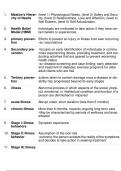Nur 155 Exam 2 (Galen)
Study online at https://quizlet.com/_ditc5p
1. Maslow's Hierar- (level 1) Physiological Needs, (level 2) Safety and Secu-
chy of Needs rity, (level 3) Relationships, Love and Affection, (level 4)
Self Esteem, (level 5) Self Actualization
2. Health Belief Individuals are motivated to take action if they have cer-
Model (HBM) tain beliefs or experiences.
3. primary preven- Efforts to prevent an injury or illness from ever occurring.
tion -ex: vaccinations
4. Secondary pre- -focuses on early identification of individuals or commu-
vention nities experiencing illness, providing treatment, and con-
ducting activities that are geared to prevent worsening
health status
-ex: disease screening and case finding; early detection
and treatment of diabetes; exercise programs for older
adult clients who are frail
5. Tertiary preven- actions taken to contain damage once a disease or dis-
tion ability has progressed beyond its early stages
6. illness Abnormal process in which aspects of the social, physi-
cal, emotional, or intellectual condition and function of a
person are diminished or impaired
7. acute illness Abrupt onset, short duration (less than 6 months)
8. chronic illness More than 6 months, requires ongoing long-term care
-May be characterized by periods of wellness and exac-
erbation
9. Stage I: illness Symptom experience
behaviors
10. Stage II: illness Assumption of the sick role
behavior -outcome: the person accepts the reality of the symptoms
and decides to take action in seeking treatment
11. Stage III: illness
behavior
, Nur 155 Exam 2 (Galen)
Study online at https://quizlet.com/_ditc5p
Medical care contact
-outcome: acceptance of the sick role or rejection of its
necessity
12. Stage IV: illness Dependent patient role
behavior -outcome: the sick individual has significant need to be
educated and provided with emotional support
13. Stage V: illness Perceived recovery
behavior -outcome: patient abandons the sick role and some pa-
tients do not give this role up lightly and begin to view
themselves as chronically ill
14. Catabolism the breaking down of substances from complex to simple
resulting in a release of energy
15. Anabolism the use of energy to change simple materials into com-
plex body substances and tissue
16. Nutrients Substances in food that your body needs to grow, to repair
itself, and to supply you with energy
-ex: build and maintain bones, muscles, and skin
17. malnutrition an imbalance in the amount of nutrient intake and the
body's needs
-ex: overweight or undernourished
18. Macronutrients nutrients needed in large amounts
-ex: carbohydrates, proteins, fats, water
19. Minerals chemicals needed for energy, muscle building, nerve con-
duction, blood clotting, and immunity to diseases
20. Vitamins organic compounds responsible for regulation of body
processes, reproduction and growth
21. Micronutrients nutrients needed by the body in limited amounts
-ex: vitamins & minerals
22. Vitamins A, D, E, K
, Nur 155 Exam 2 (Galen)
Study online at https://quizlet.com/_ditc5p
Fat soluble vita-
mins
23. Vitamin A bene- increases the resistance to infection, promotes night vi-
fits sion through the development of normal visual pigment,
develops and maintains normal function of epithelial tis-
sue, and aids in the development of normal bones and
teeth
24. Vitamin D bene- important for bone and tissue formation (in collaboration
fits with calcium and phosphorus) and collogen development
25. Vitamin E bene- antioxidant that protects cells from injury from free rad-
fits icals (by-products that result when the body transforms
food into energy)
26. Vitamin K bene- essential for the synthesis of proteins that promote clot-
fits ting or coagulation of the blood. (synthesized in the body
by bacteria found in the large intestine)
27. Vitamin C bene- synthesizes collagen, guards against cellular damage
fits from toxic chemicals and pollutants in the environment
and aids in the development of a strong immune system
by producing antibodies to fight bacteria and viruses
28. foods rich in vita- liver, milk, egg yolk, dark leafy green vegetables, yellow
min A and orange vegetables
29. foods rich in vita- dairy products, eggs, fortified food products, liver, fatty
min D fish (salmon/mackerel)
30. foods rich in vita- olive, nuts, seeds, soybeans, whole gains, legumes,
min E canola, corn, and other vegetable oil
31. foods rich in vita- dark green leafy vegetables
min K
32. foods rich in vita- fresh yellow and orange fruits, papaya, kiwi, broccoli, and
min C sweet and white potatoes




